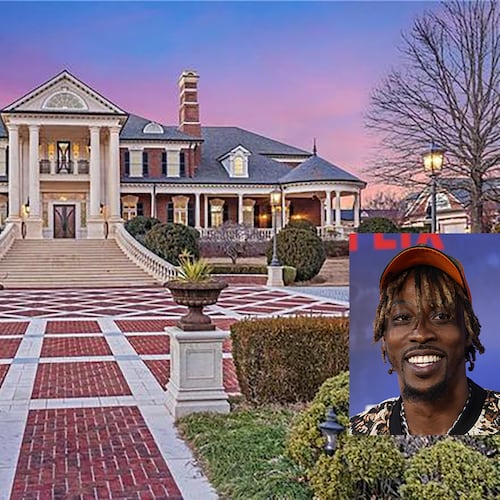In the age of Wikipedia, political spin and the conspiracy theories circulating on the world wide web, it can often be hard to ferret out the truth.
But nothing feels quite as authentic as holding a typewritten page on wispy transparency paper laced with cross-outs and addendums or a hard-bound copy of "Delta Wedding" signed by Eudora Welty. Such tangible documents of real lives and great works are housed at Emory University’s Robert W. Woodruff Library in the collections of the Manuscript, Archives, and Rare Book Library (MARBL), a hidden treasure available to the public.
To highlight the accessibility of MARBL to the community, a collection of 50 photographs of famous authors, poets and playwrights by Nancy Crampton have been paired with historical and literary items from the collection in a new exhibition called "Writers," on view through Nov. 2. To create the exhibition, curators Julie Delliquanti and Elizabeth Chase invited 18 members of the community to select the materials from MARBL. They included high school student Rock Delliquanti (Julie Delliquanti's son), Emory undergrad Thu Nguyen, Emory professor and novelist Joseph Skibell and Daren Wang, executive director of the Decatur Book Festival.
“One of our imperatives with this particular exhibition is to demonstrate that the collections are open and you don’t have to be an elite scholar working on a book or your dissertation or some important research. You can be anyone,” said Delliquanti.
Like all of the exhibitions displayed at the 3,000-square-foot Schatten Gallery on the Woodruff library’s third floor, “Writers” is a showcase for the MARBL holdings on the library’s 10th floor, in addition to a compelling forum for Crampton's iconic black-and-white literary portraits, on loan from the artist. Since the 1970s Crampton has captured the glamorous star power of these literary supernovas from Tom Stoppard to Tennessee Williams, who in a 1975 portrait looks like a rumpled middle-manager in over-sized glasses and chubby tie. In a striking 1973 portrait taken the year before her death by suicide, poet Anne Sexton is darkly beautiful, cradling a cigarette between her slender fingers. Truman Capote in seersucker and suspenders looks distinctly content, a great writer and celebrity long familiar with the camera’s gaze. Displayed alongside portraits of Eudora Welty, David Mamet and Natasha Trethewey are typewritten letters, rough drafts on legal pads, scraps of paper with story ideas alongside the books that made them famous.
A treasure trove of ephemera and rarities including the papers of Joel Chandler Harris, Ted Hughes, Alice Walker and Salman Rushdie, the MARBL collection of 250,000 rare books and materials in Southern, African American and Atlanta history and letters is regularly accessed by scholars, genealogists, high school students and Emory undergraduates. Novelist Salman Rushdie, a distinguished writer in residence at Emory, recently used the archive’s holdings while preparing his forthcoming memoir.
“We often tell new students and their parents that a first-year student can research in the papers of a famous poet such as William Butler Yeats while at the very next table in the reading room might be sitting a prize-winning scholar using exactly the very same collection,” said Ginger Smith, the interim director of MARBL has been working with the university’s special collections since 1977.
For more than 100 years, Emory has been building its archive of rare documents including an increasingly nationally recognized collection of African American literature, history and culture. At MARBL you will find not only the high-profile papers of Georgia native and “The Color Purple” author Alice Walker, but the political pamphlets and church fans that made up African American daily life.
Curated by Randall Burkett, the African American collections at MARBL draw not just from the works of Pulitzer Prize winning writers, but regular folk, “people and cultures that don’t always find their way into archives,” said Chase. The collections are not only democratic in terms of access. They are democratic by design.
The treasures contained within MARBL are vast and often delightfully esoteric and include a Civil War-era sword and a crystal ball and tarot cards that belonged to African American fortune teller Mamie Wade Avant. Within its Salman Rushdie archives MARBL contains an outline of his novel “Shame” on hotel stationary, four of Salman Rushdie’s computers including a Mac Performa 5400, and hundreds of the writer’s sticky notes. He favored orange.
It is in the quirky and poignant detritus of great minds that MARBL’s magic unfurls. Walking through the exhibition on his way to class, Jason Myers expressed a connection to a display of Mississippi writer Eudora Welty’s books, letters and a recorded interview with journalist Studs Terkel. A third year theology student at Emory, Myers also writes poetry. “I am particularly a lover of writers’ letters and so I was just reading one of Eudora Welty’s,” said Myers, who recently traveled to Welty’s home state of Mississippi. He found echoes of his visit in the Welty audio interview with its descriptions of Mississippi’s landscape and people.
“This is something that not everybody gets to see,” said Myers.
But, if the spirit moves them, almost anybody, in fact, can.
Exhibit Preview
"Writers"
Through Nov. 2. Schatten Gallery hours 9 a.m. -7 p.m. Mondays-Fridays; Saturday and Sunday hours vary according to university breaks and holidays. Check website for updated information. Manuscript, Archives, and Rare Book Library is open 9 a.m.-5:30 p.m. Mon.-Sat. Free and open to the public. Schatten Gallery, Robert W. Woodruff Library, Emory University, 540 Asbury Circle, Atlanta. 404-727-0136, www.web.library.emory.edu/libraries/schatten-gallery
About the Author
The Latest
Featured

